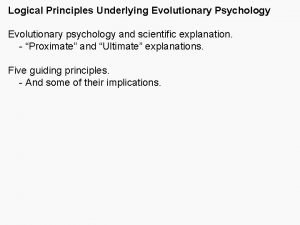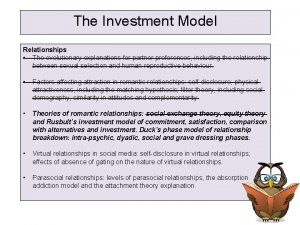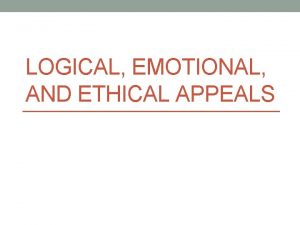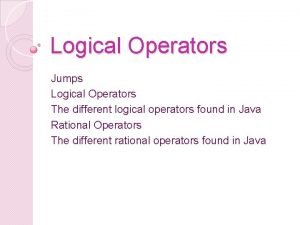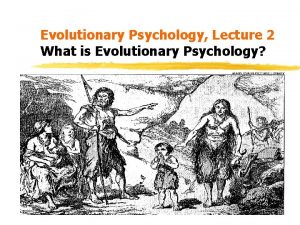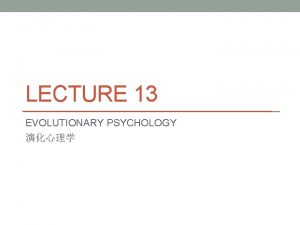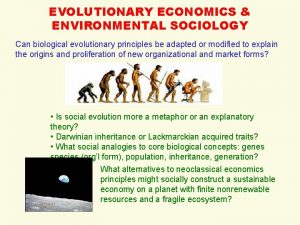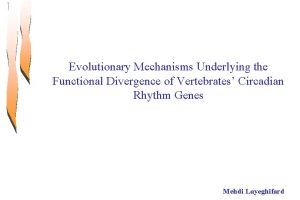Logical Principles Underlying Evolutionary Psychology Evolutionary psychology and
















![[one list of evolved learning mechanisms] ``There at least five imprinting processes, eleven varieties [one list of evolved learning mechanisms] ``There at least five imprinting processes, eleven varieties](https://slidetodoc.com/presentation_image_h/2212d3e16070e9d83b028765b581e175/image-17.jpg)




- Slides: 21

Logical Principles Underlying Evolutionary Psychology Evolutionary psychology and scientific explanation. - “Proximate” and “Ultimate” explanations. Five guiding principles. - And some of their implications.

Readings for today… Cosmides, L. , & Tooby, J. (1997). Evolutionary psychology: A primer. Center for Evolutionary Psychology; University of California, Santa Barbara. Confer, J. C. , Easton, J. A. , Fleischman, D. S. , Goetz, C. D. , Lewis, D. G. M. , Perilloux, C. , & Buss, D. M. (2010). Evolutionary psychology: Controversies, questions, prospects, and limitations. American Psychologist, 65, 110 – 126. (On website: List of things that matter most)

Evolutionary psychology and scientific explanation: Conceptual background: Four kinds of questions that ethologists ask about animal behavior (from Tinbergen) - Questions about developmental influences on behavior. - Questions about the immediate influences on behavior. - Questions about phylogenetic origins of behavior. - Questions about adaptive function of behavior.

Schematic organization of these four kinds of questions, as applied to psychological phenomena (adapted from Nesse) Ontogeny (Development) Mechanism How does [that psychological thing] develop over the course of an individual’s lifespan? What are the structures and processes that, at any particular moment in time, exert an influence on [that psychological thing]? Phylogeny Function (Adaptation) How has [that psychological thing] changed in form over the course of human evolutionary history? What (if any) selective advantage was conferred by [that psychological thing] over the course of human evolutionary history?

Schematic organization of these four kinds of questions, as applied to psychological phenomena (adapted from Nesse) Ontogeny (Development) Mechanism How does [that psychological thing] develop over the course of an individual’s lifespan? What are the structures and processes that, at any particular moment in time, exert an influence on [that psychological thing]? “Proximate” explanations Phylogeny Function (Adaptation) How has [that psychological thing] changed in form over the course of human evolutionary history? What (if any) selective advantage was conferred by [that psychological thing] over the course of human evolutionary history? “Ultimate” explanations

Five guiding principles of evolutionary psychology (from Cosmides & Tooby) Principle 1: The brain is a physical system designed to generate behavior that is appropriate to one's environmental circumstances. Principle 2: Neural circuitry is the product of evolution by natural selection, and evolved as a means of solving problems that our ancestors faced over the course of human evolutionary history. Principle 3: Consciousness is just the tip of iceberg. Principle 4: Evolved psychology is defined by functional specialization and modularity. Principle 5: Our modern skulls house a Stone Age mind.

Principle 1: The brain is a physical system designed to generate behavior that is appropriate to one's environmental circumstances. Environmental inputs “Useful” behavioral outputs Important implication: flexibility and context-contingency.

Principle 2: Neural circuitry is the product of evolution by natural selection, and evolved as a means of solving problems that our ancestors faced over the course of human evolutionary history. “Problems” = challenges to survival and/or reproduction. 2 characteristics of problems that mattered: - Recurring over long period of time. - Implications for reproduction of genes. Problems and sub-problems.

Example: BIG problem to solve: Some major sub-problems: REPRODUCE Survive long enough to reach reproductive age Engage in successful reproductive behavior

Example: BIG problem to solve: REPRODUCE Some major sub-problems: Survive long enough to reach reproductive age Some more specific sub-problems: Obtain nutrition Avoid predation Avoid deadly infections Etc. Even more specific sub-sub-problems: Engage in successful reproductive behavior Detect presence of predators Produce avoidant behavioral response Etc.

Example: BIG problem to solve: REPRODUCE Some major sub-problems: Survive long enough to reach reproductive age Some more specific sub-problems: Obtain nutrition Avoid predation Avoid deadly infections Etc. Even more specific sub-sub-problems: Etc. Engage in successful reproductive behavior

Example: BIG problem to solve: Some major sub-problems: Some more specific sub-problems: Even more specific sub-sub-problems: REPRODUCE Survive long enough to reach reproductive age Engage in successful reproductive behavior Attract “good” mate Produce offspring Help offspring survive Etc. Identify potentially “good” mates Make self attractive to those potential mates Etc.

Example: BIG problem to solve: Some major sub-problems: Some more specific sub-problems: Even more specific sub-sub-problems: REPRODUCE Survive long enough to reach reproductive age Engage in successful reproductive behavior Attract “good” mate Produce offspring Help offspring survive Etc.

Principle 3: Consciousness is just the tip of iceberg.

Principle 3: Consciousness is just the tip of iceberg.

Principle 4: Evolved psychology is defined by functional specialization. Cosmides & Tooby (1997) and Confer et al. (2010): - Limitations of “domain-general” psychological mechanisms. - Benefits of functionally-specialized mechanisms. Upshot: - Humans possess many evolved psychological mechanisms. - These mechanisms tend to be problem-specific. Examples…
![one list of evolved learning mechanisms There at least five imprinting processes eleven varieties [one list of evolved learning mechanisms] ``There at least five imprinting processes, eleven varieties](https://slidetodoc.com/presentation_image_h/2212d3e16070e9d83b028765b581e175/image-17.jpg)
[one list of evolved learning mechanisms] ``There at least five imprinting processes, eleven varieties of Pavlovian conditioning, ten of instrumental conditioning, and eight forms of mimicry and imitation…`` (Moore, 2004)


A useful metaphor: Swiss Army Knife

Principle 5: Our modern skulls house a Stone Age mind. - Important distinction between EEA and contemporary environments - Mismatches between EEA and contemporary environments. - Adapted ≠ adaptive. - Examples…

Next class: The gene’s-eye view of life Reading: Dawkins, Chapters 1 and 2:
 Even though the banana seemed to change color
Even though the banana seemed to change color Underlying principles
Underlying principles Logical equivalence
Logical equivalence Kesetaraan logis
Kesetaraan logis Ter death certificate
Ter death certificate Basic mechanisms underlying seizures and epilepsy
Basic mechanisms underlying seizures and epilepsy What is psychology
What is psychology Evolutionary perspective of psychology
Evolutionary perspective of psychology Evolutionary perspective of psychology
Evolutionary perspective of psychology Evolutionary psychology questions
Evolutionary psychology questions Rusbult's investment model
Rusbult's investment model Evolutionary psychology
Evolutionary psychology Threshold theory cummins
Threshold theory cummins Underlying theory in research
Underlying theory in research Impelism
Impelism Pitch deck template by guy kawasaki
Pitch deck template by guy kawasaki Derivatives week
Derivatives week The underlying theme of the conceptual framework is
The underlying theme of the conceptual framework is Underlying causes of ww1
Underlying causes of ww1 What were the main reasons for ww1
What were the main reasons for ww1 Kaiser wilhelm ii deformity
Kaiser wilhelm ii deformity Underlying technology
Underlying technology









